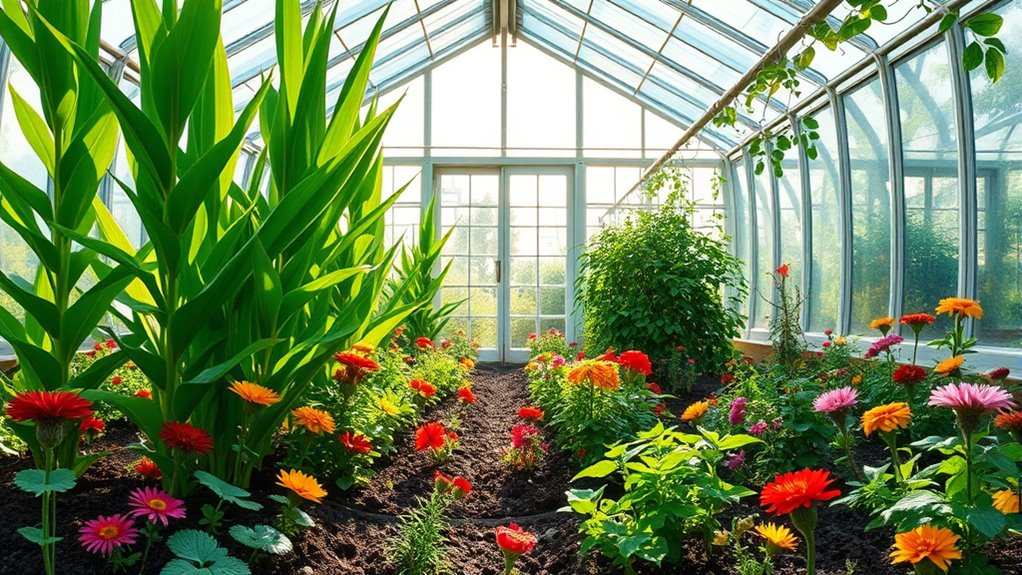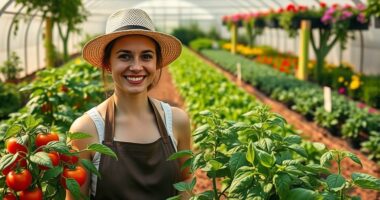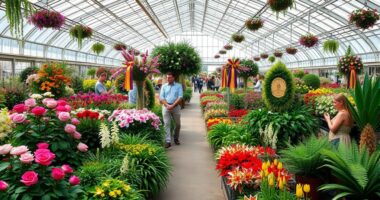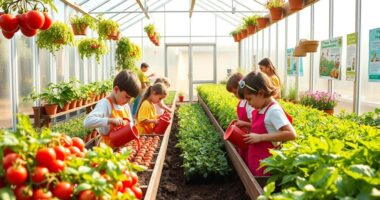Greenhouses have turned neglected gardens into vibrant spaces, showcasing their potential for transformation. You'll find inspiring stories of abandoned structures revived into community hubs that provide fresh produce and foster connections. High tunnel hoop houses offer cost-effective ways to extend growing seasons, while sustainable practices enhance the environment. With aesthetic improvements and educational opportunities, these greenhouses are not just functional—they're inspiring. Discover more about these successful transformations and how they can impact your gardening journey.
Key Takeaways
- Community gardens utilizing greenhouses increased local engagement and provided fresh produce, addressing food insecurity in urban areas.
- Greenhouses served as educational hubs, fostering hands-on learning experiences in biology and sustainability for students and community members alike.
- High tunnel hoop houses enabled extended growing seasons, enhancing resilience and promoting organic gardening techniques among local gardeners.
- Transforming vacant lots into greenhouses revitalized neglected spaces, improving aesthetics and creating vibrant community gathering areas.
- Integration of technology in greenhouse management led to optimized plant growth through better monitoring of environmental conditions and resource efficiency.
Reviving a Neglected Greenhouse: A Journey to Abundance

As you embark on the journey to revive a neglected greenhouse, it's essential to start with a thorough assessment of its current state.
Evaluate its structural integrity, note existing plants, and identify potential issues like poor ventilation or lighting. Set realistic goals based on what you can achieve within your timeframe and budget. Additionally, consider how to assess and plan for the health of the soil and plants within the greenhouse environment.
Next, identify the resources you'll need, including materials and tools for renovation. Plan for sustainability by considering energy-efficient systems that will support your greenhouse's long-term health.
Finally, create a timeline that outlines each step of the renovation process. This structured approach will lay the foundation for a successful transformation, ensuring your greenhouse can flourish once again.
From Storage to Sanctuary: Transforming Unused Spaces

Transforming unused spaces into vibrant sanctuaries can breathe new life into your community, creating areas where nature and people thrive together.
By converting vacant lots into community gardens, you not only enhance local engagement but also tackle food insecurity, providing fresh produce for healthier lifestyles. Urban agriculture aims to utilize unused or underutilized spaces for food production, contributing to local food systems. These initiatives can also promote community resilience, ensuring that neighborhoods are better prepared for emergencies.
Repurposing industrial sites into vertical farms preserves history while stimulating economic growth and job creation.
Abandoned buildings can become urban farms, fostering community centers that educate on nutrition and clean eating.
Each project reduces waste by utilizing existing structures and promotes sustainable urban development.
Your involvement in these transformations can lead to revitalized neighborhoods and improved property values, making your community a more beautiful and harmonious place to live.
High Tunnel Hoop Houses: The Perfect Solution for Small Gardens
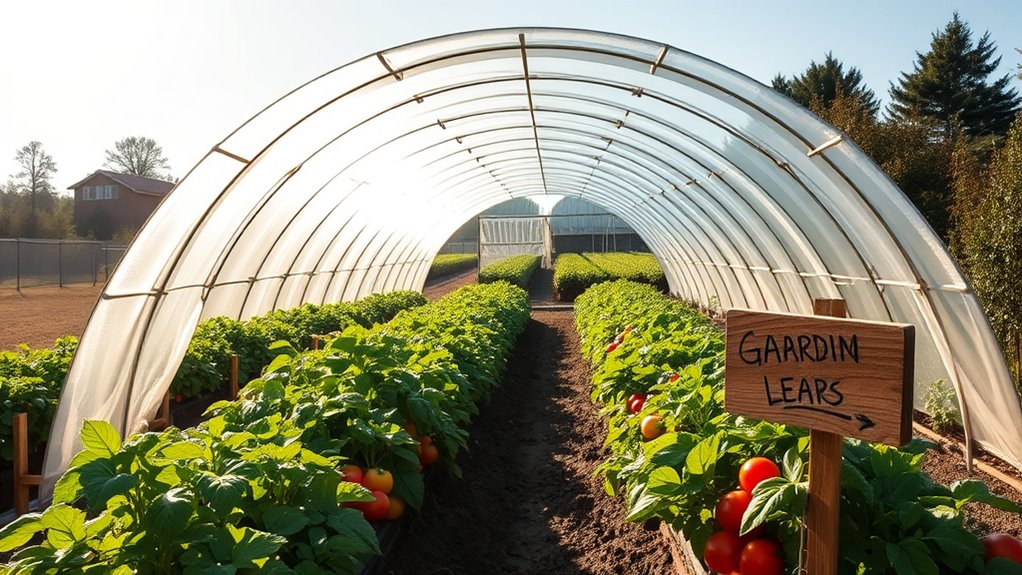
High tunnel hoop houses offer an ideal solution for small gardens, enabling you to maximize your growing potential in limited spaces.
They're cost-effective and require a lower initial investment compared to traditional greenhouses, making them accessible for everyone. You can extend your growing season, allowing for earlier spring planting and later fall harvesting. Additionally, these structures allow for planting up to six weeks earlier in spring, ensuring you can take full advantage of the growing season. Furthermore, these hoop houses can help improve indoor air quality by providing better ventilation for your plants. Investing in these structures can enhance your overall garden resilience, making them a valuable addition to your gardening arsenal. Moreover, they contribute to sustainable practices by promoting organic gardening techniques and reducing reliance on chemical inputs.
Plus, their easy setup means you won't need advanced DIY skills. These structures protect your plants from extreme weather, pests, and diseases, ensuring a healthier garden.
With various sizes available, you can find the perfect fit for your space. High tunnels also promote sustainability by reducing your carbon footprint while enhancing soil health and crop variety, making them a smart choice for any gardener.
Community Greenhouses: Fostering Connections and Growth
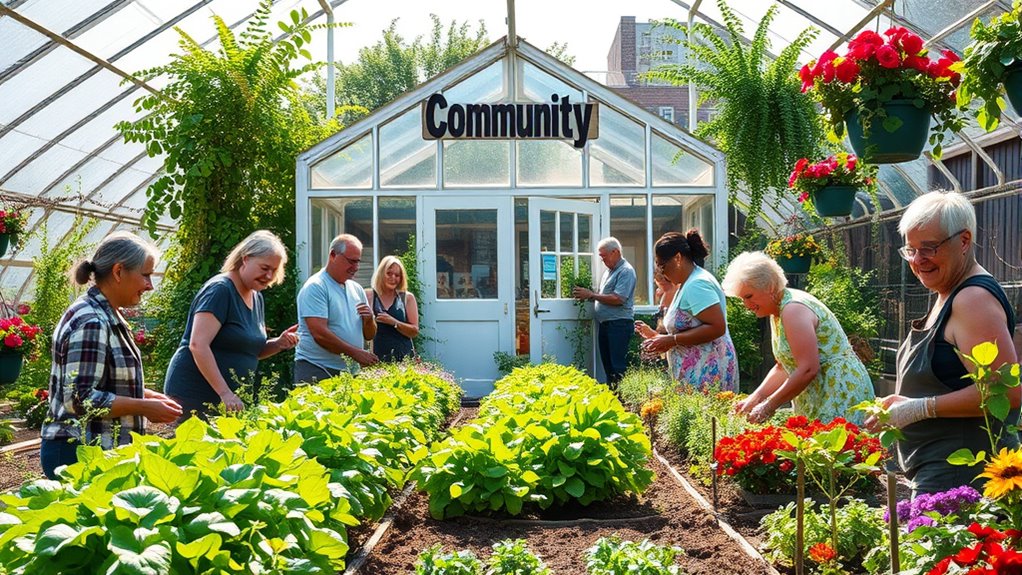
When you get involved in a community greenhouse, you're not just planting seeds; you're cultivating relationships and building a stronger community.
These greenhouses create a space for shared activities, fostering connections among neighbors. As you work together, you'll notice how teamwork enhances interpersonal skills and social cohesion. Additionally, participating in a community greenhouse can lead to increased consumption of fruits and vegetables, as community gardeners are 3.5 times more likely to eat them at least five times daily. Furthermore, engaging in such activities can promote emotional and psychological growth, as individuals learn to work collaboratively and support one another. Moreover, these collaborative efforts can also lead to enhanced living spaces that cater to the needs of seniors and their families. Engaging in community gardening can also improve cognitive development through hands-on learning experiences.
Community greenhouses cultivate not just plants, but also relationships, enhancing teamwork and fostering social bonds among neighbors.
Community greenhouses often serve as lively hubs for local events, bringing people together and encouraging engagement.
Beyond social benefits, you'll enjoy improved health outcomes as you access fresh produce, reduce stress, and stay active through gardening tasks. This vibrant environment not only nourishes your body but also strengthens bonds, making it a vital part of your community.
Embrace the growth and connections that come with your involvement!
Sustainable Practices: A Greenhouse That Supports the Environment
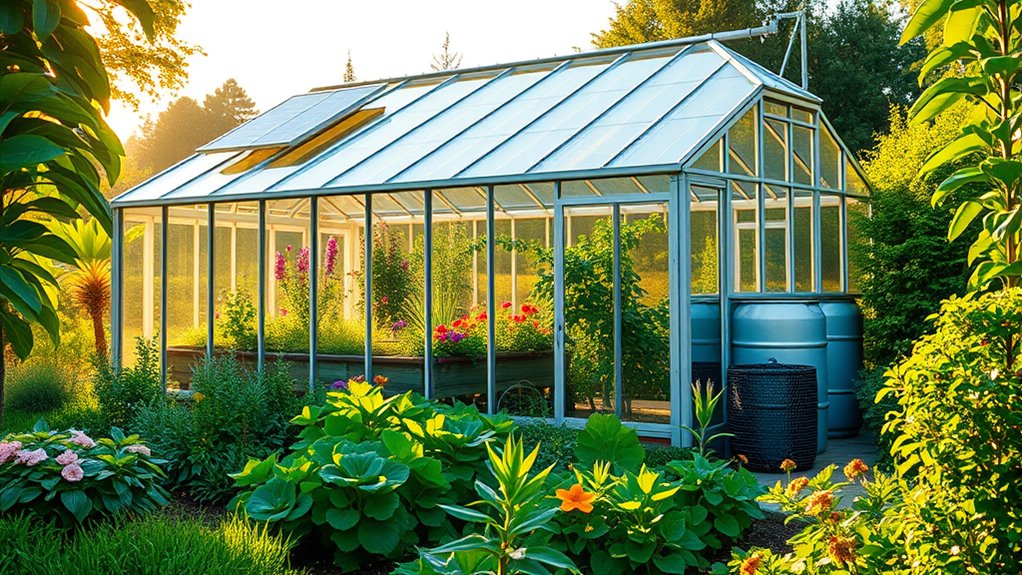
Sustainable practices in greenhouse management not only benefit the environment but also enhance your gardening experience.
By using recycled materials like reclaimed wood and polycarbonate panels, you reduce waste while ensuring durability and insulation. Consider bamboo for frameworks—it's fast-growing and sustainable.
Maximize energy efficiency with passive solar design and geothermal heating systems, helping you control climate naturally. Energy-efficient heating systems can significantly lower your greenhouse's overall energy consumption. Additionally, utilizing geothermal energy can provide a consistent and eco-friendly heating solution for your greenhouse. Incorporating high-fiber vegetables such as kale can also contribute to your greenhouse's productivity and nutritional value. A focus on biodiversity hotspots can further enhance the ecological impact of your greenhouse.
Install rainwater harvesting systems and drip irrigation to conserve water effectively.
Enhance soil health through composting, crop rotation, and organic fertilizers, ensuring your plants thrive without harmful chemicals.
Your greenhouse can also serve as an educational hub, teaching others about sustainability and biodiversity.
Aesthetic Improvements: Adding Charm to Functional Spaces
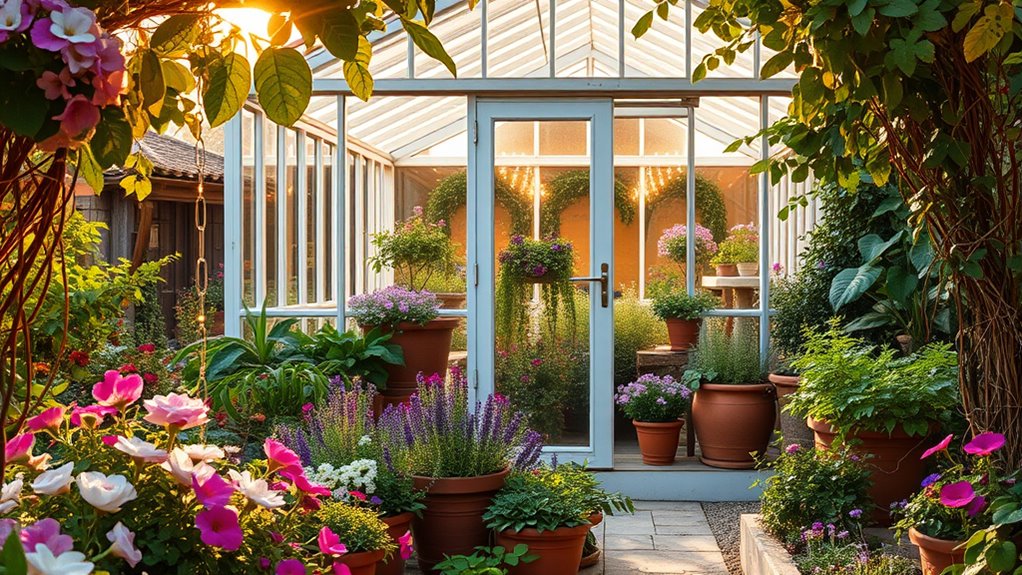
Transforming your greenhouse into an inviting and charming space elevates both its functionality and your gardening experience.
Start by incorporating innovative flooring, like LED strip lighting, which not only enhances aesthetics but also provides essential light for your plants. Additionally, consider a multi-level foundation to optimize space and create distinct microclimates for your plants.
Incorporate LED strip lighting for a stylish floor that brightens your greenhouse and supports plant growth.
Create multi-level foundations to optimize space and visual interest. Wooden accents, such as reclaimed hardwood, add warmth while promoting sustainability.
Integrating furniture, like cozy couches or desks, turns your greenhouse into a relaxing retreat.
Add decorative elements, such as hanging plants and stylish trellises, to infuse charm into the environment.
These aesthetic improvements make your greenhouse not just a place for growing plants but a delightful sanctuary that enhances your time spent among your greenery.
Educational Opportunities: Inspiring the Next Generation of Gardeners
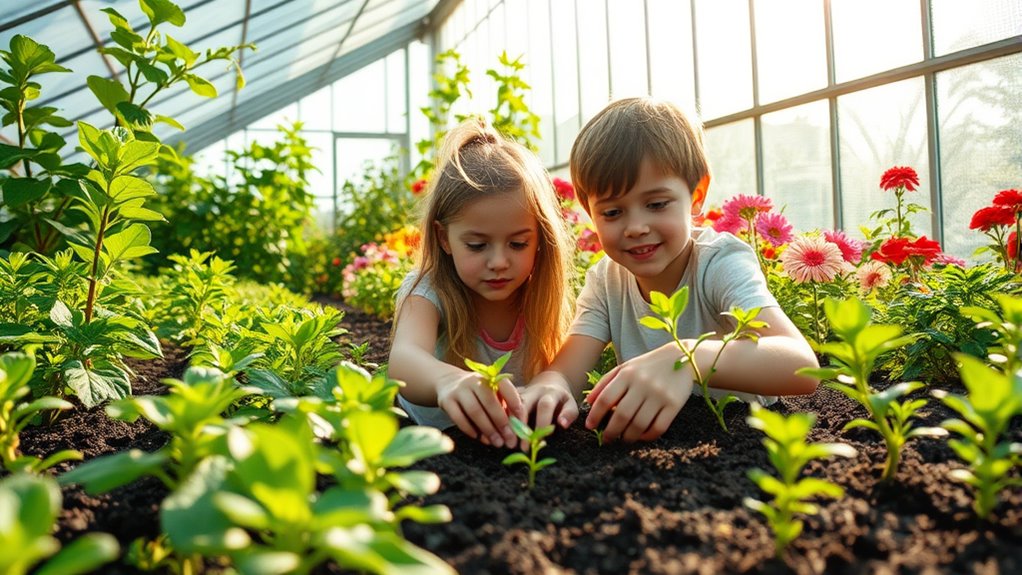
As you step into a greenhouse, you're not just entering a space for growing plants; you're entering a dynamic classroom filled with opportunities to inspire the next generation of gardeners.
Here, hands-on learning allows you to plant, nurture, and observe growth, deepening your understanding of biology. You can experiment with STEM concepts, manipulating variables like light and humidity while employing technology for environmental control. This environment also teaches sustainability concepts, highlighting the importance of organic practices and composting.
This interdisciplinary approach integrates math, language arts, and social studies into gardening. You'll also gain insight into sustainability, food security, and climate change.
Frequently Asked Questions
What Are the Costs Associated With Greenhouse Renovations?
When you're considering greenhouse renovations, you'll typically face costs around $1,460 on average, though it can range from $375 to $3,000.
Expect to pay $5 to $25 per square foot for materials, and labor can run $50 to $200 per hour, depending on the type of repairs needed.
Factors like size, material selection, and location will influence your overall expenses, so plan accordingly to keep your budget in check.
How Can I Choose the Right Greenhouse for My Needs?
Finding your perfect greenhouse starts with a few fundamental factors.
First, focus on your climate; choose materials that insulate well in your area.
Next, think about your space; lean-to options suit snug spots, while freestanding structures fit larger lots.
Define your gardening goals to guide size and features.
Lastly, factor in your budget; striking a balance between quality and cost will create a greenhouse that meets your needs without breaking the bank.
What Common Pests Affect Greenhouse Plants?
Common pests that affect greenhouse plants include aphids, spider mites, whiteflies, and thrips.
You'll notice aphids distorting leaves, while spider mites create yellowing leaves and webs.
Whiteflies suck sap and leave a sticky residue, attracting other pests.
Thrips damage plant tissue and spread diseases.
To manage these pests, regularly inspect your plants, maintain cleanliness, and consider using biological or chemical control methods to keep your greenhouse healthy and thriving.
How Do I Maintain Optimal Humidity Levels Inside a Greenhouse?
To maintain optimal humidity levels inside your greenhouse, regularly monitor with a hygrometer.
If humidity's too low, use misting systems or humidifiers to increase it. Conversely, ventilate by opening doors or windows if it's too high.
You can also employ dehumidifiers or adjust watering practices.
Automating your climate control with smart sensors helps you make real-time adjustments, ensuring a healthy environment for your plants throughout the seasons.
Can Greenhouses Be Used Year-Round in All Climates?
You might think greenhouses are just for the fair-weather gardener, but they can actually thrive year-round in various climates.
By choosing the right materials and design, you can create a cozy haven for your plants, even in harsh conditions.
With effective insulation, smart ventilation, and a bit of automation, your greenhouse can support year-round growth.
Conclusion
In transforming gardens with greenhouses, you've not only revived spaces but also fostered community and growth. Did you know that community greenhouses can increase local food production by up to 30%? By creating sustainable and aesthetically pleasing environments, you're inspiring the next generation of gardeners while making a positive impact on the environment. Embrace the journey of these success stories, and you'll see how greenhouses can turn neglected areas into thriving sanctuaries of abundance.
